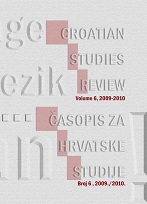Nazorov jezik u službi metrike
A Metrical Analysis of the Language of Vladimir Nazor
Author(s): Anita Runjić-Stoilova, Marijana Tomelić ĆurlinSubject(s): Literary Texts
Published by: Croatian Studies Centre
Keywords: metrics; accent; Croatian language; Chakavian dialect; Shtokavian dialect; Vladimir Nazor
Summary/Abstract: The work of Vladimir Nazor is characterized by diversity in genre, theme and style. In this article the authors focus on the characteristics of style in Nazor’s poetry, or, more precisely, they analyse the metric qualities in the language of his poetry. Special emphasis is given to specific linguistic elements comprising Nazor’s poetics. Even though Nazor is considered one of Croatia’s greatest Chakavian poets, he primarily wrote in Shtokavian. However, his entire poetic oeuvre was imbued with his native Chakavian dialect. In spite of his great endeavors, Nazor never truly managed to master the use of Shtokavian stylistic and accent norms. Insecurity in the usage of accents hindered his efforts in achieving harmonious versification. This problem is 318 especially evident in the early poetry collections Lirika (1910), Nove pjesme (1913), Intima (1915) and Niza od koralja (1922). For the purpose of analysis in this paper, approximately twenty poems were selected from Nazor’s great and varied poetic oeuvre, poems that were composed in his early Shtokavian period and which feature the obvious influence of the Chakavian dialect. This paper analyzes metrics because this is where Nazor’s struggle with mastering Shtokavian is mainly reflected. The goal of this article is thus to provide a metrical analysis of Nazor’s language. This analysis also includes the usage of disyllabic pronunciation of diphthongs, the apocope of infinitive affixes, abbreviated past and present verbal adverbs, the singular masculine active participle form, plural forms, dialectal lexis, etc. The question of the disyllabic pronunciation of diphthongs is important when discussing Nazor’s poetry, his metrics and his orthoepic irregularities. Standard Croatian has never featured the disyllabic pronunciation of diphthongs. However, Nazor used it in an attempt to achieve certain types of metre in his verses. Nazor frequently used the apostrophe to mark the elision of a vowel, as well as abbreviations. These include: the omission of certain vowels at the beginning, middle or the end of words; the omission of the last vowel in infinitives; the contraction of the vowel group ao into the active participle; and abbreviated plurals. Nazor also used obscure and unusual forms of well-known words. The Shtokavian accent presented an exceptional problem to Nazor, who was not well versed in it. Many Shtokavian words were not a part of his native idiom; he lacked the feeling for shifting the accent to the proclitic. If he sometimes shifted the accent in his verses, he then marked it as well, having learned that it was the proper, formal form. However, his poetry contained a greater number of examples where this shifting should have occurred and yet it did not. Nazor was well aware of his continuous erring with metre. However, he did not have a role model or a textbook to turn to.
Journal: Croatian Studies Review - Časopis hrvatskih studija
- Issue Year: 2011
- Issue No: 7
- Page Range: 307-318
- Page Count: 12
- Language: Croatian

